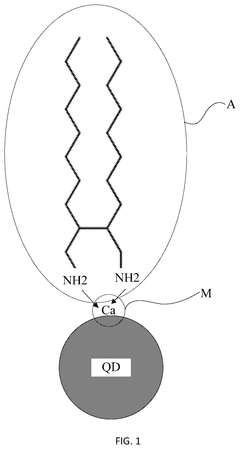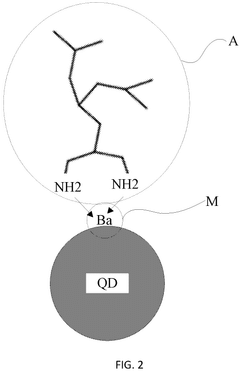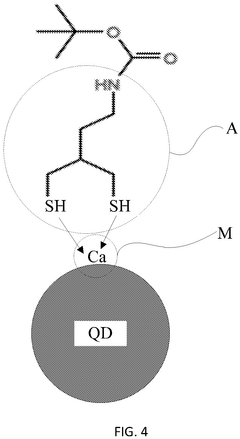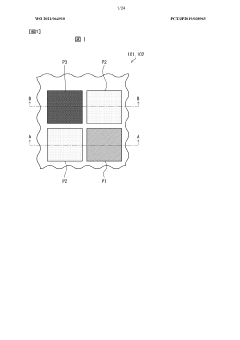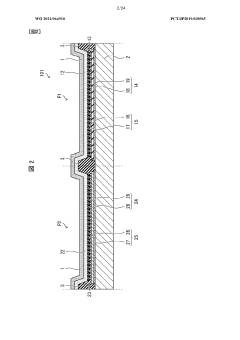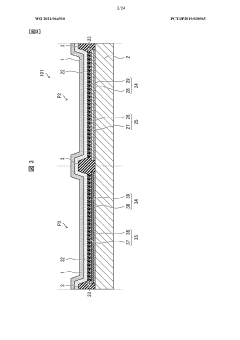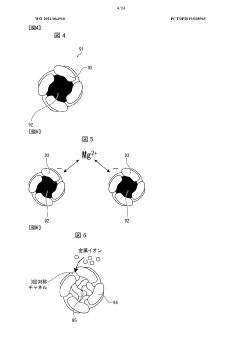How to Troubleshoot Common QLED Display Issues?
JUN 19, 20258 MIN READ
Generate Your Research Report Instantly with AI Agent
Patsnap Eureka helps you evaluate technical feasibility & market potential.
QLED Display Evolution
QLED display technology has undergone significant evolution since its inception, marking a series of advancements in the field of display technology. The journey began with the development of quantum dot light-emitting diodes (QLEDs) in the early 2000s, which promised enhanced color reproduction and energy efficiency compared to traditional LED displays.
The first major milestone in QLED evolution came with the commercialization of quantum dot-enhanced LCD TVs in the mid-2010s. These displays used a quantum dot film to improve color accuracy and brightness, while still relying on LCD technology for image formation. This hybrid approach allowed manufacturers to leverage existing LCD production infrastructure while offering improved picture quality.
As research progressed, true QLED displays emerged, utilizing quantum dots as the primary light-emitting material. This breakthrough enabled displays with even better color reproduction, wider color gamut, and improved energy efficiency. The technology also allowed for thinner and more flexible display designs, opening up new possibilities for product form factors.
Recent years have seen further refinements in QLED technology, including the development of cadmium-free quantum dots to address environmental concerns. Additionally, advancements in quantum dot synthesis and deposition techniques have led to improved uniformity and stability of QLED displays, enhancing their longevity and performance consistency.
The integration of QLED technology with other display innovations has been a key trend in its evolution. For instance, the combination of QLED with mini-LED backlighting has resulted in displays with superior local dimming capabilities, offering deeper blacks and higher contrast ratios. This hybrid approach has positioned QLED as a strong competitor to OLED technology in the high-end display market.
Looking towards the future, the QLED display evolution is expected to continue with a focus on several key areas. These include the development of self-emissive QLED pixels, which would eliminate the need for a separate backlight, potentially rivaling OLED in terms of picture quality and form factor flexibility. Additionally, research is ongoing to improve the efficiency and color purity of blue quantum dots, which has been a persistent challenge in QLED technology.
As QLED displays become more prevalent in consumer electronics, efforts are also being made to enhance their durability and reduce production costs. This includes exploring new materials and manufacturing processes that can streamline production while maintaining or improving display quality. The evolution of QLED technology continues to drive innovation in the display industry, promising even more impressive visual experiences in the years to come.
The first major milestone in QLED evolution came with the commercialization of quantum dot-enhanced LCD TVs in the mid-2010s. These displays used a quantum dot film to improve color accuracy and brightness, while still relying on LCD technology for image formation. This hybrid approach allowed manufacturers to leverage existing LCD production infrastructure while offering improved picture quality.
As research progressed, true QLED displays emerged, utilizing quantum dots as the primary light-emitting material. This breakthrough enabled displays with even better color reproduction, wider color gamut, and improved energy efficiency. The technology also allowed for thinner and more flexible display designs, opening up new possibilities for product form factors.
Recent years have seen further refinements in QLED technology, including the development of cadmium-free quantum dots to address environmental concerns. Additionally, advancements in quantum dot synthesis and deposition techniques have led to improved uniformity and stability of QLED displays, enhancing their longevity and performance consistency.
The integration of QLED technology with other display innovations has been a key trend in its evolution. For instance, the combination of QLED with mini-LED backlighting has resulted in displays with superior local dimming capabilities, offering deeper blacks and higher contrast ratios. This hybrid approach has positioned QLED as a strong competitor to OLED technology in the high-end display market.
Looking towards the future, the QLED display evolution is expected to continue with a focus on several key areas. These include the development of self-emissive QLED pixels, which would eliminate the need for a separate backlight, potentially rivaling OLED in terms of picture quality and form factor flexibility. Additionally, research is ongoing to improve the efficiency and color purity of blue quantum dots, which has been a persistent challenge in QLED technology.
As QLED displays become more prevalent in consumer electronics, efforts are also being made to enhance their durability and reduce production costs. This includes exploring new materials and manufacturing processes that can streamline production while maintaining or improving display quality. The evolution of QLED technology continues to drive innovation in the display industry, promising even more impressive visual experiences in the years to come.
QLED Market Analysis
The QLED display market has experienced significant growth in recent years, driven by increasing demand for high-quality visual experiences in various applications. As consumers seek superior picture quality, energy efficiency, and longer lifespan in their display devices, QLED technology has emerged as a compelling solution. The market for QLED displays spans across multiple sectors, including consumer electronics, commercial displays, and automotive applications.
In the consumer electronics segment, QLED TVs have gained substantial traction, competing directly with OLED technology. Major manufacturers such as Samsung, TCL, and Hisense have invested heavily in QLED technology, expanding their product lines and driving market growth. The adoption of QLED displays in smartphones and tablets is also on the rise, albeit at a slower pace compared to the TV market.
The commercial display sector has shown increasing interest in QLED technology, particularly for digital signage, control rooms, and large-format displays. The ability of QLED displays to deliver high brightness, wide color gamut, and excellent visibility in various lighting conditions makes them well-suited for these applications.
In the automotive industry, QLED displays are gaining popularity for in-vehicle infotainment systems and digital instrument clusters. The technology's high contrast ratio and color accuracy contribute to improved readability and enhanced user experience in automotive environments.
Market analysis indicates that the Asia-Pacific region, particularly China and South Korea, leads in QLED display production and adoption. North America and Europe follow closely, with growing consumer demand for premium display technologies.
The QLED market faces competition from other display technologies, primarily OLED. While QLED offers advantages in brightness and longevity, OLED maintains an edge in contrast ratio and viewing angles. This competition drives continuous innovation and improvement in both technologies.
Looking ahead, the QLED market is expected to continue its growth trajectory. Factors contributing to this growth include ongoing technological advancements, increasing consumer awareness, and expanding applications in emerging fields such as augmented reality and virtual reality displays. As manufacturers address common issues and improve overall performance, the QLED market is poised for further expansion and market share gains in the global display industry.
In the consumer electronics segment, QLED TVs have gained substantial traction, competing directly with OLED technology. Major manufacturers such as Samsung, TCL, and Hisense have invested heavily in QLED technology, expanding their product lines and driving market growth. The adoption of QLED displays in smartphones and tablets is also on the rise, albeit at a slower pace compared to the TV market.
The commercial display sector has shown increasing interest in QLED technology, particularly for digital signage, control rooms, and large-format displays. The ability of QLED displays to deliver high brightness, wide color gamut, and excellent visibility in various lighting conditions makes them well-suited for these applications.
In the automotive industry, QLED displays are gaining popularity for in-vehicle infotainment systems and digital instrument clusters. The technology's high contrast ratio and color accuracy contribute to improved readability and enhanced user experience in automotive environments.
Market analysis indicates that the Asia-Pacific region, particularly China and South Korea, leads in QLED display production and adoption. North America and Europe follow closely, with growing consumer demand for premium display technologies.
The QLED market faces competition from other display technologies, primarily OLED. While QLED offers advantages in brightness and longevity, OLED maintains an edge in contrast ratio and viewing angles. This competition drives continuous innovation and improvement in both technologies.
Looking ahead, the QLED market is expected to continue its growth trajectory. Factors contributing to this growth include ongoing technological advancements, increasing consumer awareness, and expanding applications in emerging fields such as augmented reality and virtual reality displays. As manufacturers address common issues and improve overall performance, the QLED market is poised for further expansion and market share gains in the global display industry.
QLED Tech Challenges
QLED display technology, while offering numerous advantages, faces several technical challenges that require ongoing research and development efforts. One of the primary issues is color accuracy and consistency across different viewing angles. As the quantum dots responsible for color emission are typically encapsulated in a film or layer, maintaining uniform color distribution and intensity across the entire display surface can be problematic, especially when viewed from off-center angles.
Another significant challenge lies in the longevity and stability of quantum dots. These nanocrystals are susceptible to degradation over time, particularly when exposed to heat, moisture, and oxygen. This degradation can lead to a reduction in color performance and overall display quality, necessitating the development of more robust encapsulation methods and materials to protect the quantum dots from environmental factors.
The manufacturing process for QLED displays also presents challenges, particularly in achieving consistent quantum dot size and distribution. The size of quantum dots directly affects their light emission properties, and even small variations can result in color inconsistencies across the display. Ensuring uniformity in quantum dot deposition and maintaining precise control over their size during production are critical factors in producing high-quality QLED displays.
Power efficiency remains an ongoing concern for QLED technology. While QLEDs are generally more energy-efficient than traditional LED-LCD displays, there is still room for improvement, especially in terms of reducing power consumption without compromising brightness and color performance. This challenge is particularly relevant for mobile devices and other applications where battery life is a crucial factor.
Additionally, the blue light emission in QLED displays poses a unique challenge. The blue quantum dots tend to have shorter lifespans compared to their red and green counterparts, which can lead to color shift over time. Developing more stable blue quantum dots or alternative blue light sources that maintain consistency with the quantum dot-generated colors is an area of active research.
Lastly, the cost of production for QLED displays remains a significant hurdle for widespread adoption. While prices have decreased over time, the complex manufacturing processes and materials involved in producing quantum dots still contribute to higher costs compared to some competing display technologies. Addressing this challenge through improved manufacturing techniques and economies of scale is crucial for the continued growth and competitiveness of QLED technology in the display market.
Another significant challenge lies in the longevity and stability of quantum dots. These nanocrystals are susceptible to degradation over time, particularly when exposed to heat, moisture, and oxygen. This degradation can lead to a reduction in color performance and overall display quality, necessitating the development of more robust encapsulation methods and materials to protect the quantum dots from environmental factors.
The manufacturing process for QLED displays also presents challenges, particularly in achieving consistent quantum dot size and distribution. The size of quantum dots directly affects their light emission properties, and even small variations can result in color inconsistencies across the display. Ensuring uniformity in quantum dot deposition and maintaining precise control over their size during production are critical factors in producing high-quality QLED displays.
Power efficiency remains an ongoing concern for QLED technology. While QLEDs are generally more energy-efficient than traditional LED-LCD displays, there is still room for improvement, especially in terms of reducing power consumption without compromising brightness and color performance. This challenge is particularly relevant for mobile devices and other applications where battery life is a crucial factor.
Additionally, the blue light emission in QLED displays poses a unique challenge. The blue quantum dots tend to have shorter lifespans compared to their red and green counterparts, which can lead to color shift over time. Developing more stable blue quantum dots or alternative blue light sources that maintain consistency with the quantum dot-generated colors is an area of active research.
Lastly, the cost of production for QLED displays remains a significant hurdle for widespread adoption. While prices have decreased over time, the complex manufacturing processes and materials involved in producing quantum dots still contribute to higher costs compared to some competing display technologies. Addressing this challenge through improved manufacturing techniques and economies of scale is crucial for the continued growth and competitiveness of QLED technology in the display market.
QLED Troubleshooting
01 Quantum dot light-emitting diode (QLED) structure optimization
Improvements in QLED structure to enhance display performance and address issues such as color accuracy, brightness, and efficiency. This includes optimizing quantum dot layers, electrode configurations, and light-emitting materials to reduce display artifacts and improve overall image quality.- Color accuracy and uniformity issues: QLED displays may face challenges in maintaining color accuracy and uniformity across the screen. This can result in inconsistent color reproduction, affecting image quality and viewer experience. Techniques to improve color calibration and enhance uniformity are being developed to address these issues.
- Quantum dot degradation: Over time, quantum dots in QLED displays may degrade, leading to reduced brightness and color performance. Research is focused on developing more stable quantum dot materials and protective encapsulation methods to extend the lifespan of QLED displays and maintain consistent performance.
- Backlight bleeding and halo effect: QLED displays using LED backlighting can experience light bleeding around the edges of the screen or a halo effect around bright objects on dark backgrounds. Improved local dimming technologies and optimized optical designs are being explored to minimize these issues and enhance contrast ratios.
- Power consumption and heat management: QLED displays may consume significant power, especially at high brightness levels, leading to heat generation issues. Efforts are being made to develop more energy-efficient quantum dot materials and improve thermal management systems to reduce power consumption and heat dissipation problems.
- Viewing angle limitations: Some QLED displays may experience color shift or reduced brightness when viewed from off-center angles. Research is ongoing to improve quantum dot film structures and optical designs to enhance viewing angles and maintain consistent image quality across different viewing positions.
02 Color management and calibration techniques
Development of advanced color management systems and calibration methods to address color shift, gamut mapping, and uniformity issues in QLED displays. These techniques aim to improve color accuracy, consistency, and reproduction across the display panel.Expand Specific Solutions03 Thermal management solutions
Implementation of thermal management strategies to mitigate heat-related display issues in QLED panels. This includes the design of heat dissipation structures, temperature-sensitive materials, and cooling systems to maintain optimal performance and longevity of the display.Expand Specific Solutions04 Backlight and local dimming enhancements
Advancements in backlight technology and local dimming algorithms to improve contrast, reduce blooming, and enhance overall picture quality in QLED displays. These innovations aim to address issues related to black levels, HDR performance, and uniformity across the screen.Expand Specific Solutions05 Image processing and artifact reduction
Development of sophisticated image processing algorithms and hardware solutions to reduce visual artifacts such as motion blur, banding, and color fringing in QLED displays. These techniques aim to enhance the overall viewing experience and address common display issues.Expand Specific Solutions
QLED Industry Leaders
The QLED display market is in a growth phase, with increasing demand for high-quality visual experiences driving market expansion. The global QLED market size is projected to reach significant value in the coming years. Technologically, QLED displays are maturing, with major players like BOE Technology Group, Sharp Corp., and LG Electronics leading innovation. These companies are investing heavily in R&D to address common issues such as color accuracy, brightness uniformity, and longevity. Emerging players like Shenzhen China Star Optoelectronics and Hefei Visionox Technology are also contributing to technological advancements. The competitive landscape is characterized by a mix of established electronics giants and specialized display manufacturers, all vying for market share through continuous improvement in QLED technology.
BOE Technology Group Co., Ltd.
Technical Solution: BOE has developed advanced QLED display technologies, including their ADS Pro technology for enhanced viewing angles and color accuracy. They utilize quantum dot color conversion films to achieve a wider color gamut and higher brightness. BOE's QLED panels incorporate local dimming technology for improved contrast ratios and HDR performance. Their troubleshooting approach includes advanced quality control systems during manufacturing and software-based diagnostics for identifying and resolving common issues such as color uniformity, backlight bleeding, and dead pixels.
Strengths: Large-scale production capabilities, advanced panel technologies. Weaknesses: Potential for quality inconsistencies in mass production.
Shenzhen China Star Optoelectronics Semicon Display Tech Co.
Technical Solution: CSOT has developed a proprietary QLED technology called H-QLED, which uses hybrid quantum dot materials to enhance color performance and energy efficiency. Their troubleshooting process involves a combination of hardware and software solutions. They employ AI-driven image processing algorithms to detect and correct display anomalies in real-time. CSOT also implements a multi-layer quality assurance system during production to minimize defects. For common issues like image retention or color shift, they provide firmware updates and user-adjustable settings in their display management software.
Strengths: Innovative quantum dot technology, strong AI integration. Weaknesses: Relatively newer to the QLED market compared to some competitors.
QLED Fault Analysis
Core-shell quantum dot, quantum dot light-emitting device, display apparatus and manufacturing method
PatentPendingUS20250145883A1
Innovation
- The development of core-shell quantum dots with a shell layer containing metal ions and a chelating ligand that forms a stable closed ring structure, enhancing ligand adsorption and preventing detachment during patterning and device operation.
Display device and display device production method
PatentWO2021064910A1
Innovation
- The method involves forming light-emitting layers with quantum dots and peptides that bind to specific metal surfaces on pixel electrodes, eliminating the need for partition walls by using different metal materials for each pixel electrode, allowing for selective placement of quantum dots through electrostatic interactions, thereby increasing the aperture ratio and brightness.
QLED Quality Control
Quality control is a critical aspect of QLED display manufacturing, ensuring that the final product meets the highest standards of performance and reliability. The process begins with rigorous testing of individual components, including quantum dots, LED backlights, and color filters. Each element undergoes thorough inspection to verify its conformity to specifications before assembly.
During production, automated optical inspection systems are employed to detect defects such as dead pixels, color inconsistencies, and uniformity issues. These systems use high-resolution cameras and advanced image processing algorithms to identify even the smallest imperfections that may be invisible to the human eye. Any panels that fail to meet the predetermined quality thresholds are immediately flagged for further inspection or rejection.
Calibration is another crucial step in QLED quality control. Each display undergoes precise color calibration to ensure accurate color reproduction across the entire color gamut. This process involves adjusting the quantum dot layer and fine-tuning the backlight to achieve optimal color performance. Advanced spectrophotometers and colorimeters are used to measure and verify the display's color accuracy, contrast ratio, and brightness levels.
Reliability testing is conducted to simulate real-world usage conditions and assess the long-term performance of QLED displays. This includes stress tests for temperature variations, humidity exposure, and prolonged operation. Accelerated aging tests are performed to predict the display's lifespan and identify potential issues that may arise over time, such as color shift or brightness degradation.
Quality control also extends to the evaluation of the display's power consumption and energy efficiency. Specialized equipment measures the power draw under various operating conditions to ensure compliance with energy standards and optimize overall performance. Additionally, electromagnetic compatibility (EMC) testing is carried out to verify that the QLED display does not emit harmful electromagnetic interference and can operate reliably in the presence of other electronic devices.
Finally, a series of visual inspections by trained technicians complement the automated processes. These experts assess subjective aspects of image quality, such as motion handling, viewing angles, and overall visual appeal. Their trained eyes can catch subtle issues that may have escaped automated detection, ensuring that only the highest quality QLED displays reach the end-users.
During production, automated optical inspection systems are employed to detect defects such as dead pixels, color inconsistencies, and uniformity issues. These systems use high-resolution cameras and advanced image processing algorithms to identify even the smallest imperfections that may be invisible to the human eye. Any panels that fail to meet the predetermined quality thresholds are immediately flagged for further inspection or rejection.
Calibration is another crucial step in QLED quality control. Each display undergoes precise color calibration to ensure accurate color reproduction across the entire color gamut. This process involves adjusting the quantum dot layer and fine-tuning the backlight to achieve optimal color performance. Advanced spectrophotometers and colorimeters are used to measure and verify the display's color accuracy, contrast ratio, and brightness levels.
Reliability testing is conducted to simulate real-world usage conditions and assess the long-term performance of QLED displays. This includes stress tests for temperature variations, humidity exposure, and prolonged operation. Accelerated aging tests are performed to predict the display's lifespan and identify potential issues that may arise over time, such as color shift or brightness degradation.
Quality control also extends to the evaluation of the display's power consumption and energy efficiency. Specialized equipment measures the power draw under various operating conditions to ensure compliance with energy standards and optimize overall performance. Additionally, electromagnetic compatibility (EMC) testing is carried out to verify that the QLED display does not emit harmful electromagnetic interference and can operate reliably in the presence of other electronic devices.
Finally, a series of visual inspections by trained technicians complement the automated processes. These experts assess subjective aspects of image quality, such as motion handling, viewing angles, and overall visual appeal. Their trained eyes can catch subtle issues that may have escaped automated detection, ensuring that only the highest quality QLED displays reach the end-users.
QLED User Experience
QLED displays have revolutionized the viewing experience for consumers, offering vibrant colors, deep blacks, and impressive brightness levels. However, like any advanced technology, QLED displays can encounter issues that affect user satisfaction. Understanding and addressing these common problems is crucial for maintaining a positive user experience.
One of the most frequently reported issues is image retention or burn-in, where static elements of the display persist even after the content changes. While less common in QLED displays compared to OLED, it can still occur, particularly with prolonged display of static images. Users may notice faint outlines of previously displayed content, which can be distracting and diminish overall picture quality.
Color accuracy and consistency are paramount for QLED displays, yet some users report issues with color shifting or banding. This can manifest as uneven color distribution across the screen or abrupt changes in color gradients. Such issues can significantly impact the viewing experience, especially for content that relies heavily on subtle color variations, such as nature documentaries or professional photography.
Another concern for QLED users is backlight bleeding, where light from the LED backlight seeps through around the edges of the screen, particularly noticeable in dark scenes. This can create distracting bright spots and reduce the perceived contrast ratio, detracting from the immersive viewing experience that QLED technology promises.
Motion handling is a critical aspect of display performance, and some QLED users report issues with motion blur or judder. Fast-moving objects or camera pans may appear less sharp or exhibit stuttering, which can be particularly problematic for sports enthusiasts or action movie fans.
Brightness inconsistencies across the screen, often referred to as clouding or dirty screen effect, can also impact user satisfaction. This issue is characterized by uneven luminance, where certain areas of the screen appear brighter or darker than others, even when displaying a uniform color.
To address these issues and enhance user experience, manufacturers have implemented various technologies and features. Local dimming algorithms have been refined to improve contrast and reduce backlight bleeding. Advanced color management systems and quantum dot technology continue to evolve, offering more accurate and consistent color reproduction.
Motion enhancement technologies, such as black frame insertion and variable refresh rates, have been introduced to combat motion blur and judder. Additionally, automatic picture calibration features are becoming more common, allowing users to maintain optimal picture quality over time with minimal effort.
One of the most frequently reported issues is image retention or burn-in, where static elements of the display persist even after the content changes. While less common in QLED displays compared to OLED, it can still occur, particularly with prolonged display of static images. Users may notice faint outlines of previously displayed content, which can be distracting and diminish overall picture quality.
Color accuracy and consistency are paramount for QLED displays, yet some users report issues with color shifting or banding. This can manifest as uneven color distribution across the screen or abrupt changes in color gradients. Such issues can significantly impact the viewing experience, especially for content that relies heavily on subtle color variations, such as nature documentaries or professional photography.
Another concern for QLED users is backlight bleeding, where light from the LED backlight seeps through around the edges of the screen, particularly noticeable in dark scenes. This can create distracting bright spots and reduce the perceived contrast ratio, detracting from the immersive viewing experience that QLED technology promises.
Motion handling is a critical aspect of display performance, and some QLED users report issues with motion blur or judder. Fast-moving objects or camera pans may appear less sharp or exhibit stuttering, which can be particularly problematic for sports enthusiasts or action movie fans.
Brightness inconsistencies across the screen, often referred to as clouding or dirty screen effect, can also impact user satisfaction. This issue is characterized by uneven luminance, where certain areas of the screen appear brighter or darker than others, even when displaying a uniform color.
To address these issues and enhance user experience, manufacturers have implemented various technologies and features. Local dimming algorithms have been refined to improve contrast and reduce backlight bleeding. Advanced color management systems and quantum dot technology continue to evolve, offering more accurate and consistent color reproduction.
Motion enhancement technologies, such as black frame insertion and variable refresh rates, have been introduced to combat motion blur and judder. Additionally, automatic picture calibration features are becoming more common, allowing users to maintain optimal picture quality over time with minimal effort.
Unlock deeper insights with Patsnap Eureka Quick Research — get a full tech report to explore trends and direct your research. Try now!
Generate Your Research Report Instantly with AI Agent
Supercharge your innovation with Patsnap Eureka AI Agent Platform!
